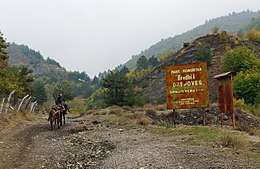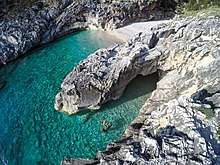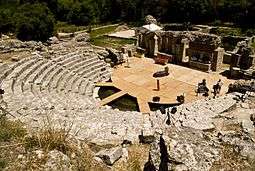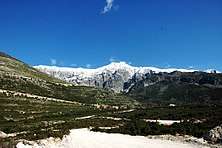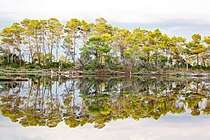Biodiversity of Albania
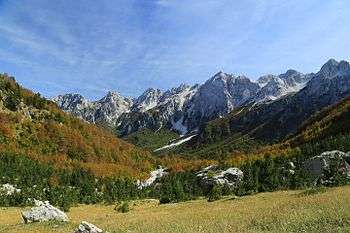
For a small country, Albania is characterised by a wealth of terrestrial and marine ecosystems and habitats with contrasting floral and faunal species, defined in an area of 28,748 square kilometres. Most of the country is predominantly of mediterranean character, comprehending the country's center and south, while the alpine affinity is more visible in the northeast.[1]
Apart the diversity of topography and climate, the direct proximity of Albania to the Mediterranean Sea and the significant location within the European Continent, have created favorable conditions for appearance of a vast array of flora and fauna with an immense quality, which, however, led the country to be recognised as an important biodiversity hotspot in the continent.[2][3][4] The amount of globally threatened faunal species in Albania is high with an integral part of more than 181 species, ranking seventh in the Mediterranean Basin.[5]
Albania is predominantly mountainous and hilly with the rapid landscape change from marine to alpine within a short distance. Only one-third consists of lowlands that sprawls across the west of the country facing the Mediterranean Sea with a coastline length of about 476 km (296 mi).[6] The mountain chains crosses consequently the length of the country from the north to the south featuring the Albanian Alps in the north, the Sharr Mountains in the northeast, the Skanderbeg Mountains in the center, the Korab Mountains in the east, the Pindus Mountains in the southeast and the Ceraunian Mountains in the southwest stretching alongside the Albanian Riviera.
The hydrographic network of Albania is composed of lakes, rivers, wetlands, seas and groundwaters. There are about 250 lakes of different origins, including tectonic, glacial and fluvial lakes. Among the most important is the lake of Shkodër, the largest lake in Southern Europe, followed by Ohrid, which is considered as one of the most ancient lakes in the world. The rivers have also an important effect on the local's coastal biodiversity. There are 152 rivers in the country, most notable amongst them Drin, Vjosa, Shkumbin, Mat, Ishëm and Osum. The coasts along the Mediterranean Sea are home to various lagoons including Karavasta and Narta.
Protected areas belong to the most essential instruments of nature conservation. 799 types of protected areas are designated in Albania, covering a surface of 5.216,96 square kilometres.[7] Amongst them 14 national parks, 1 marine park, 4 ramsar sites, 3 world heritage sites, 45 important plant areas, 16 important bird areas and 786 protected areas of various caterogies.[8][9][10][11][12]
Ecoregions
The country of Albania is part of the Boreal Kingdom and stretches specifically within the Illyrian province of the Circumboreal Region. Its territory can be conventionally subdivided into four terrestrial ecoregions of the Palearctic ecozone.[13][14] The Illyrian deciduous forests stretches along the Albanian Adriatic and Ionian Sea Coast in the west across the Mediterranean Basin, while the Pindus Mountains mixed forests occur in the Eastern and Southeastern Mountain Ranges in the east. The Dinaric Mountains mixed forests covers most of the Albanian Alps in the north, while the Balkan mixed forests extend across the eastern end of the range.
Ecosystems
Forests
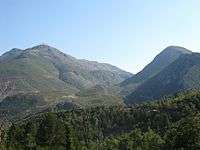
Forests are the most widespread terrestrial ecosystem in Albania. They represent an essential functional and aesthetic component on 36% of the landscapes in the country.[17][18][19] The forests of northern Albania are similar to that of Continental Europe, in contrast, those of southern Albania refer similarities with that of the Mediterranean Basin.[20]
Forests can take many forms, depending on their latitude, soil, rainfall and prevailing temperatures. The concentration of deciduous trees dominates in the country's forests, ranging from almost 56.8% or 6,093 square kilometres of the forested territory.[19] Oak represents an important natural forest resource in Albania with 32.1% followed by beech with 18.4%. There are 12 oak species to be found in Albania distributed all across the country's territory from north to south, and east to west.[21]
The coniferous forests cover 1,756 square kilometres which constitutes 16.4% of the country's forested total area. Although, black pine dominates and is among the most significant tree species in the country, occupying an surface area of roughly 10.2%.[19] It is primary found in the central mountain range but also scattered in the northern and southern mountain range.[22] Silver fir accounts 1.4% of the conifers with 152 square kilometres, commonly found in the slopes and valleys of the mountains and alongside the Albanian Adriatic and Ionain Sea coasts in the west.[19][23]
Wetlands
Albania has a wealth of wetland ecosystems supporting diverse and unique habitats. These wetlands contain numerous ecological commodities and services but are under an important charge due to the rapid urbanization and industrialization. Marshes, reed beds and lakes are found in all regions, along with rivers, and deltas while wetlands are distributed from the high internally mountainous zone in the southeast to the coastline in the west.[24]
The richest wetland regions are more particularly in the coastal plain along the entire west border of Albania that is shaped by the Adriatic and Ionian Sea.[25] The wetland complex of Butrint, Karavasta and Narta represents one of the most important coastal wetland sites of Albania. The lagoons are separated from the sea by rather narrow sandy bars, which continuously change in size and shape. Other important lagoons include the Patoku Lagoon, Kune-Vain Lagoon, Viluni Lagoon and many others.
Albania is home to several of the most important lakes in Southern Europe. Four lakes are apportioned with its neighbouring countries for instance Lake Shkodër with Montenegro, Lake Ohrid with the Republic of Macedonia, Small Lake Prespa with Greece and Lake Prespa with Macedonia and Greece. All of them are nevertheless of international importance not least for the limnology and biodiversity.[25] Moreover, Lake Shkoder and Lake Prespa has been recognised as a wetland of international importance by designation under the Ramsar Convention.[26]
Estuaries
An estuary is a partly enclosed coastal body of water that form at river mouths and provide unique habitats for migratory bird populations, invertebrates, as well as marine fish, including those that visit to breed. The main characteristics of estuarine life are the variability in salinity and sedimentation. They are determined by a region's geology, and influenced by topographical, chemical and climatic conditions.
Although small in size, Albania has many rivers that flow through its expanses. The major rivers of Albania are the Drin, Vjosa, Mat, Ishëm, Erzen, Shkumbin and Seman that discharges into the eastern Adriatic Sea. River flows are highly variable with high flows in winter and early spring and dramatically lower flows in the late summer.
In addition, the rivers have received little scientific attention from biologists and little is known about the status of biodiversity they contain, however, the river basin of Drin is one of the most important biodiversity hotspots in Europe.[27][28]
Flora
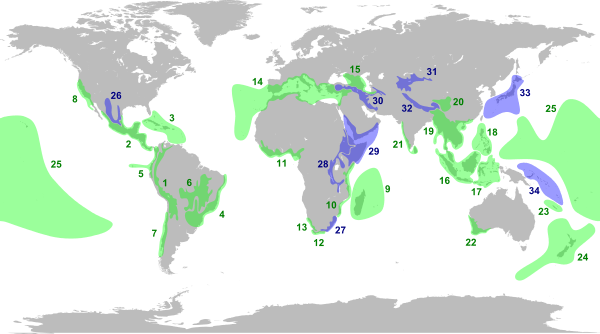
Albania features contrasting and different vegetation types, determined mainly by topography, hydrology, climate and geology. It enjoys a diversity of temperate ecologies, incorporating both deciduous and coniferous forests, wetlands, river deltas, alpine and subalpine pastures and meadows, evergreen and broadleaf bushes, marine and coastal landscapes.
Strategically located on the northern shore of the Mediterranean Sea, Albania appertain to one of the planet's biodiversity hotspots due to the high level of endemism within the Mediterranean Basin.[29] The flora of Albania consists of more than 3,200 vascular[30] and 2,350 non-vascular plants and a lesser known number of fungi.[18] The main elements of the country's flora are 24% mediterranean, 22% balkanic, 18% european and 14% eurasian.[31][32]
Phytogeographically, the country straddles the Illyrian province of the Circumboreal Region within the Boreal Kingdom. According to the World Wide Fund for Nature and the European Environment Agency, it falls within four terrestrial ecoregions of the Palearctic ecozone, including the Illyrian deciduous forests, Balkan mixed forests, Pindus Mountains mixed forests and Dinaric Alpine mixed forests.
About 3,000 different species of plants grow in Albania, many of which are used for medicinal purposes. Coastal regions and lowlands have typical Mediterranean macchia vegetation, whereas oak forests and vegetation are found on higher elevations. Vast forests of black pine, beech and fir are found on higher mountains and alpine grasslands grow at elevations above 1800 meters.[33] The genus of flora with the most species in Albana Trifolium (clover) with a total of 63 species. This is mainly due to the Mediterranean climate on the coastline of the nation. The country is also home to almost 27 species of Verbascum, which is due to the greater proximity to Anatolia, that is the main development center of the king candles.
Fauna
Birds
.jpg)
The geographical location and variable and complex climate of Albania are responsible for its richly diverse bird population. About 353 species of bird have been recorded in Albania exclusively 11 globally threatened species and only one that was introduced by humans. The country has excellent wetlands, lagoons, lakes, estuaries and deltas together with the corresponding habitats. These habitats serve as feeding ground for thousands of migrating birds that travels between Northern Africa and Europe through the Adriatic flyway.[34][35]
_in_Divjak%C3%AB-Karavasta%2C_Albania.jpg)
There are numerous raptor species found in Albania, some of which are the eagles, hawks, falcons and vultures. The eagles are widespread over the country while different species inhabit different habitats. The golden eagle is the largest bird of prey and especially found in mountainous areas, cliffs and remote areas of Albania.
The white-tailed eagle is found wherever there are large bodies of water and takes mainly fish and occasionally other vertebrates.[36] The short-toed snake eagle is a forest species and takes mostly snakes but also some lizards. There is a great plenty of hawk species found across the country including the eurasian sparrowhawk, the levant sparrowhawk and the northern goshawk.
The falcons that occur in the country are well represented by a number of species. They are represented by the eleonora's falcon, eurasian hobby, lanner falcon, peregrine falcon, saker falcon and merlin. A dozen species of vulture can be found living in the country mainly in certain parts of gorges, on cliffs, rocks and caves. Among the most important and prominent species is the globally threatened egyptian vulture. These birds inhabits mainly the southern of Albania but can be found in very few territories in the north.[37]
Located in the Mediterranean Sea, Albania has a rich marine avifauna with many large and various seabird colonies dotted around its pristine coastline in the west. Pelicans and flamingos are more commonly found in the coastal areas. The extremely rare dalmatian pelican is the most common pelican in the country and very heavy for a flying bird.[38] The greater flamingo, which is out of the six species of flamingo on our planet, can be found along warm, watery regions especially in lagoons such as in Karavasta Lagoon and Narta Lagoon.
Mammals
Albania is home to a wide range of mammals that are closely associated with its geographical location and climatic conditions. Approximately 58 species of mammals have been recorded to occur in the country. The protected areas, including national parks, nature reserves and biosphere reserves, provide protection to the mammals and are the most likely locations where these animals can be seen.
.jpeg)
For a small country, Albania plays an important role in maintaining and ensuring the long term survival of the large carnivores of the western and southern Balkan Peninsula.[40][41] The carnivores seem to be mainly distributed in the last remaining forests throughout the country especially in the areas around the Albanian Alps in the north, the Korab Mountains in the east and the scattered high areas in the south, such as in the Karaburun Peninsula, Valamara Mountains and Nemërçka Mountains.
The country's big cat species include the eurasian lynx, balkan lynx and wildcat.[42] All of them are critically endangered, threatened and protected. The country is host to at present the largest distribution area of the critically endangered balkan lynx, which is considered to be the largest cat in the Balkans, with an estimated population of less than 100 individuals.[43][44][45]
.jpg)
The canidae family has several members in Albania including the gray wolf, eurasian wolf, red fox and golden jackal. The distribution range of the gray and eurasian wolf encompasses most of the country's territory.[47][48] The red fox, which is native, is the largest fox species and appears in every corner of Albania.[49] However, the range of the golden jackal extends across the Western Lowlands along the Albanian Adriatic and Ionian Sea Coast.[50][51][52][53]
The brown bear, perhaps Albania's most famous wildlife species, is one of the most valuable elements of the biodiversity and plays as well as an important role in biodiversity maintenance.[54] They are found across much of the country, including the Northern, Central and Southern Mountain Range of Albania, and are part of the Dinaric-Pindus population, which is the second largest population in Europe.[54] The brown bear populations in both Albania and the Republic of Macedonia are of significant and important biological and genetic value, as they constitute the connecting populations between the bears of the countries of Serbia, Croatia and Slovenia in the northern of the Balkans and the bears of Greece in the south.[55]

The largest family of carnivorous mammals belongs to the otters, badgers, weasels and martens, all of which are found in the country. All of these are short, furry animals with short, rounded ears and thick fur, but they differ markedly in size, habit and habitat. The eurasian otter is found throughout much of the country and healthy populations were localised in rivers and marshes in the northwest and in the south.[57][58] The european badger is the most common badger in Albania and found across much of the country's territory.[59]
Classified as carnivores, pinnipeds are divided between earless seals and eared seals. Earless seals do not have ears and cannot get their hind flippers underneath their bodies to crawl. In contrast, eared seals have protruding ears and can walk with all four limbs on land. Nevertheless, the mediterranean monk seal, among the world's rarest pinniped species,[60] is the only seal species that can be found in Albania. It is primarily home in the rocky coastal regions of southern Albania such as in Karaburun Peninsula, Sazan Island and Ksamil Islands that provide good habitats for the endangered species.

Considering the great availability of water, the country's coast is estimated to be 381 kilometres (237 mi) long.[62] The Mediterranean Sea, which includes the Adriatic Sea and the Ionian Sea that makes up the entire west border of Albania, is home to increasingly rare populations of cetaceans.[63][64][65] Nonetheless, the country has several cetacean species that live in the Albanian Mediterranean Sea.
At least one subspecies of the common dolphin are known to inhabit coastal waters such as off the short-beaked common dolphin.[66] The common bottlenose dolphin is abundant along the Albanian Adriatic Sea Coast especially in winter and spring seasons where they come to coastal areas to breed.[67] Areas to protect the dolphin species were established in Buna River-Velipoja, Karaburun-Sazan, Ksamil Islands, Vjosa-Narta and other places.[68][69] Therefore, the cuvier's beaked whale has been recorded several times in Albanian waters.[70][71]
The even-toed ungulates are represented by species such as the red deer, roe deer, fallow deer[72] and chamois. The red deer is among the largest herbivore in the country and particularly one of the most popular species of the forests of the country. The fallow deer is usually, in contrast to the red deer, brown with lighter patches and a white stomach, but the colour can vary greatly.
Reptiles
Despite the fact that there are no exact studies, Albania ranks among the most important regions in the Balkan Peninsula in terms of reptiles with over thirty seven species being recorded here.[73][74] Many of them are widespread particularly along the Albanian coasts that contains a wide diversity of habitats and ecosystems.

There are several species of sea turtle that nest on the country's beaches.[76] The loggerhead turtle is a large oceanic turtle with flippers and a reddish brown shell.[77] The green sea turtle is another important species in the Mediterranean Sea and occasionally found in the Bay of Drin in the north and Bay of Vlorë in the south of Albania.[78] The hawksbill sea turtle is one of the world's most endangered sea turtles and basically found in tropical waters around the world but also occasionally in Albania.[79]
The territory of Albania is populated by two important species of freshwater turtles such as the european pond turtle and the balkan pond turtle.[80] One of the best-known turtles of Albania is the hermann's tortoise which is relatively abundant throughout the country. Lizards are also found in the country. Large lizards such as the european green lizard, balkan green lizard, mediterranean house gecko and blue-throated keeled lizard are probably the country's most regularly encountered reptiles.
Fish
Albania has approximately 249 fish species in its coastal waters and 64 freshwater species in its rivers and lakes.[73] Even though fish of marine and freshwaters can be found in various parts of waters throughout the country. The Adriatic and Ionian Sea inside the Mediterranean Sea are home of salt water fish, while fresh water fish occurs on Lake Butrint, Lake Shkodër, Lake Ohrid, Lake Prespa as well as in Karavasta Lagoon, Narta Lagoon and Patos Lagoon.
Lake Ohrid, Europe's oldest lake, is located between Albania and Macedonia.[81] As one of the world's few ancient lakes, it is the lake which contains the largest number of endemic species in the world, with 212 species of animals and plants.[82][83] It is the habitat for many rare fish species such as the endangered Ohrid trout, one of the most ancient trout in the entire Balkan Peninsula.[84][85][86]
With more than 28 species identified, out of 38 species which were recorded for the entire Adriatic Sea, the diversity of sharks in Albania is among the most abundant in the Balkans.[87] Among the most important and common species are the small-spotted catshark, nursehound, common smooth-hound, longnose spurdog, spiny dogfish, angelshark and common thresher.
National parks
See also
References
- ↑ MINISTRY ENVIROINMENT, FORESTS AND WATER ADMINISTRATION BIODIVERSITY DIRECTORATE. "FOURTH NATIONAL REPORT TO THE UNITED NATIONS CONVENTION ON BIOLOGICAL DIVERSITY" (PDF). cbd.int. Tirana. p. 6.
- ↑ Deutsche Gesellschaft für Internationale Zusammenarbeit (GIZ) GmbH. "NATIONAL ASSESSMENT OF BIODIVERSITY INFORMATION MANAGEMENTAND REPORTING BASELINE FOR ALBANIA" (PDF). balkangreenenergynews.com. p. 10.
- ↑ "Biodiversity Albania". climatechangepost.com.
Some of the 30% of the European plant species, and 42% of the European mammals can be found in the country. Albania's variety of wetlands, lagoons and large lakes also provide critical winter habitat for migratory birds (1).
- ↑ "BIODIVERSITY IN ALBANIA REPORT ON NATIONAL SITUATION OF BIODIVERSITY IN ALBANIA" (PDF). macfungi.webs.com. p. 2.
Approximately 30% of all European floras occur in Albania.
- ↑ "Mediterranean Basin Biodiversity Hotspot" (PDF). cepf.net. p. 62.
- ↑ Eftimi, R. "SOME CONSIDERATIONS ON SEAWATER-FRESHWATER RELATIONSHIP IN ALBANIAN COASTAL AREA" (PDF). ITA Consult.
- ↑ UNEP, IUCN, WCMC. "ALBANIA". protectedplanet.net. p. 1.
- ↑ UNESCO. "Ohrid-Prespa". unesco.org.
- ↑ UNESCO. "Albania". whc.unesco.org.
- ↑ Ramsar Convention. "ALBANIA" (PDF). ramsar.org.
- ↑ "Important Plant Areas of the south and east Mediterranean region" (PDF). portals.iucn.org. p. 76.
- ↑ BirdLife International. "Albania". datazone.birdlife.org.
- ↑ NaturAL. "Albania towards NATURA 2000". natura.al. Tirana. p. 1.
- ↑ "The National Parks Of Albania The fifteen national parks in Albania encompass an area of 210,668.48 hectares which accounts for about 3.65% of the overall territory of the country". worldatlas.com.
The territory of Albania can be divided into four ecoregions: Dinaric Alpine (mixed forests in the far north). Balcanic (mixed forest in the north-east). Pindus mountain (mixed forests covering the central and southeast mountains). Illyrian deciduous (forest covering the rest of the country).
- ↑ UNESCO World Heritage Sites. "Ancient and Primeval Beech Forests of the Carpathians and Other Regions of Europe". whc.unesco.org. p. 1.
- ↑ Euronatur. "Report of the Excursion to Ancient Beech Forests in Albania and Macedonia July 14-19, 2013" (PDF). euronatur.org. pp. 1–20.
- ↑ Ministry of Environment. "Document of Strategic Policies for the Protection of Biodiversity in Albania" (PDF). cbd.int. p. 15.
- 1 2 Ministry of Environment. "FIFTH NATIONAL REPORT OF ALBANIA TO THE UNITED NATIONS CONVENTION ON BIOLOGICAL DIVERSITY (CBD)" (PDF). cbd.int. p. 4.
- 1 2 3 4 UNECE. "Albania Environmental Performance Reviews" (PDF). unece.org. p. 141.
- ↑ "lbania Biodiversity Assessment Under the Biodiversity and Forestry Indefinite Quantity Contract Contract No. LAG-I-00-99-00013-00, Task Order No. 811" (PDF). rmportal.net. November 2003. pp. 16–23.
- ↑ FAO. "State of Forest Tree Genetic Resources in Albania" (PDF). fao.org. p. 5.
- ↑ FAO. "Black pine resources in Albania". fao.org. p. 1.
- ↑ FAO. "FOREST GENETIC RESOURCES" (PDF). ftp.fao.org. p. 48.
- 1 2 "Conservation Status of Albanian Coastal Wetlands and their Colonial Waterbird Populations (Pelecaniformes and Ciconiiformes)" (PDF). vliz.be. Brussels. pp. 1–10.
- 1 2 The Wetlands of Central and Eastern Europe (Book). IUCN, 1993. 1993. pp. 14–15. ISBN 9782831701424.
- ↑ Ramsar Convention (3 July 2013). "Albania adds its parts of the Prespa Lakes to the Ramsar List". ramsar.org.
- ↑ "The natural wealth and legacy of the Drin River Basin: inspiring our collective actions" (PDF). act4drin.net. p. 7.
- ↑ "Drin River Basin The blue heart of the Balkans" (PDF). mio-ecsde.org. p. 4.
- ↑ IUCN. "Mediterranean Hotspot". iucn.org.
- ↑ Mehmet Metaj. "BIODIVERSITY AND THE PROTECTED AREAS SYSTEM IN ALBANIA" (PDF). cqm.rs. pp. 1–8.
- ↑ "BIODIVERSITY IN ALBANIA REPORT ON NATIONAL SITUATION OF BIODIVERSITY IN ALBANIA" (PDF). catsg.org. p. 3.
- ↑ "ALBANIA – BIODIVERSITY CONSERVATION DATA". medomed.org.
- ↑ Bego, Ferdinand and Koni, Mynyr (1999) "Albania" in Blodlverslty Strategy and Action Plan. The National Environmental Agency
- ↑ Euronatur. "Adriatic Flyway". euronatur.org.
- ↑ Euronatur. "ADRIATIC FLYWAY - BIRD CONSERVATION ON THE BALKANS" (PDF). euronatur.org.
- ↑ "BIODIVERSITY IN ALBANIA REPORT ON NATIONAL SITUATION OF BIODIVERSITY IN ALBANIA" (PDF). catsg.org. Tirana. p. 28.
- ↑ IUCN Red List. "Save the Egyptian Vulture on the Balkans". iucnredlist.org.
- ↑ Euronatur. "Dalmatian Pelicans Help for the rarest pelican in the world". euronatur.org.
- ↑ European Green Belt. "Balkan Green Belt as Ecological Corridor for Wolf, Bear and Lynx". europeangreenbelt.org.
- ↑ Ferdinand Bego, Nikolla Peja, Stavri Pllaha. "Large Carnivores (Bear, Lynx and Wolf) in Albania" (PDF). catsg.org. p. 1.
- ↑ Dr. Ferdinand Bego. "On the status and distribution of the large carnivores (Mammalia: Carnivora) in Albania" (PDF). catsg.org. Tirana. p. 1.
- ↑ "Die potentielle Verbreitung der Wildkatze (Felis silvestris silvestris) in Österreich als Entscheidungsgrundlage für weitere Schutzmaßnahmen" (PDF). wildkatze-in-oesterreich.at (in German and English). Salzburg. p. 19.
- ↑ "The Balkan Lynx Conservation Compendium". Catsg.org. Retrieved 29 December 2009.
- ↑ "Wildlife of Albania". iberianature.com.
- ↑ "Balkan Lynx Recovery Program". ppnea.org.
- ↑ "Management Plan Llogora-Rreza e Kanalit-Dukat -Orikum-TragjasRadhime-Karaburun Complex Site" (PDF). vinc.s.free.fr. p. 76.
- ↑ "Report on the conservation status and threats for wolf (Canis lupus) in Europe" (PDF). euronatur.org. p. 7.
- ↑ "On the status and distribution of the large carnivores (Mammalia: Carnivora) in Albania" (PDF). catsg.org. Tirana. p. 4.
- ↑ "RISK ASSESSMENT FOR AUSTRALIA – Red Fox, (Vulpes vulpes) (Linnaeus, 1758)" (PDF). pestsmart.org.au. p. 4.
- ↑ Dokumentation einer zweiten Einwanderungswelle des Goldschakals Canis aureus LINNAEUS 1758 in Österreich aus den Jahren 2003-2006. "Dokumentation einer zweiten Einwanderungswelle des Goldschakals Canis aureus LINNAEUS 1758 in Österreich aus den Jahren 2003-2006" (PDF). zobodat.at (in German). p. 5.
- ↑ World Wide Fund for Nature. "Conservation Action Plan for the golden jackal (Canis aureus) in Greece" (PDF). wwf.gr. p. 8.
- ↑ Mammal Species of the World: A Taxonomic and Geographic Reference. Johns Hopkins University Press. 2005. pp. 574–575. ISBN 978-0801882210.
- ↑ "Assessment of golden jackal species (Canis aureus, L.1758) records in natural areas out of their known historic range". researchgate.net/p. Retrieved 12 February 2016.
- 1 2 Ferdinand Bego - University of Tirana (2007). "The Brown Bear (Ursus arctos) Action Plan". researchgate.net. Tirana.
- ↑ "STATUS OF BROWN BEARS (Ursus arctos) IN ALBANIA AND FYROM" (PDF). bearbiology.com. Athens. p. 6.
- ↑ Ferdinand Bego, Alfred Mullaj, Lefter Kashta, Albana Zotaj. "THE STATUS OF THE HABITATS OF EUROPEAN CONSERVATION INTEREST ALONG THE ADRIATIC COAST OF ALBANIA" (PDF). researchgate.net. Tirana. p. 1.
- ↑ Giuseppe Bogliani, Claudio Prigioni, Francesco Barbieri. "The otter Lutra lutra in Albania". researchgate.net.
- ↑ ALESSANDRO BALESTRIERI, SIMONE MESSINA, FRANCESCA PELLA, CLAUDIO PRIGIONI , NICOLA SAINO and MAURO FASOLA. "Eurasian otter Lutra lutra in developing countries: a resurvey of Albania 22 years after the fall of communism" (PDF). cambridge.org.
- ↑ Huw I. Griffiths, David H. Thomas, Council of Europe (1997-01-01). The Conservation and Management of the European Badger (Meles Meles): (revised Results of an Enquiry Into the Species, Originally Presented as a Report to the Standing Committee of the Convention on the Conservation of European Wildlife and Natural Habitats, on the Population and Management Status and Conservation Needs of the Species in the Western Palaearctic). Council of Europe, 1997. pp. 8–9. ISBN 9789287134479.
- ↑ Karamanlidis, A. & Dendrinos, P. (2015). "Monachus monachus". IUCN Red List of Threatened Species. 2015: e.T13653A45227543. doi:10.2305/IUCN.UK.2015-4.RLTS.T13653A45227543.en.
- ↑ "Management Plan for National Marine Park Karaburun-Sazan" (PDF). mcpa.iwlearn.org. p. 29.
- ↑ Sustainable Development of Sea-Corridors and Coastal Waters: The TEN ECOPORT project in South East Europe (Chrysostomos Stylios, Tania Floqi, Jordan Marinski, Leonardo Damiani ed.). Springer. 2015-04-07. p. 85. ISBN 9783319113852.
- ↑ Ministria e Mjedisit, Pyjeve dhe Administrimit të Ujrave. "Protected area gap assessment, marine biodiversity and legislation on marine protected areas" (PDF). undp.org. Tirana. p. 38.
- ↑ Giuseppe Notarbartolo di Sciara. "Cetacean Species Occurring in the Mediterranean and Black Seas" (PDF). oceandocs.org. Rome, Italy. p. 2.
- ↑ United Nations Economic Commission for Europe. "ENVIRONMENTAL PERFORMANCE REVIEWS ALBANIA Third Review" (PDF). unece.org. p. 78.
- ↑ IUCN Red List of Threatened Species. "Delphinus delphis (Mediterranean subpopulation)". iucnredlist.org. p. 1.
- ↑ "Montenegrins Battle to Save Endangered Dolphins". balkaninsight.com. 26 May 2015.
- ↑ "Inland observations of the common bottlenose dolphins tursiops truncatus (montagu, 1821) in the delta of the Bojana/Buna River, Albania and Montenegro" (PDF). dlib.si. pp. 1–4.
- ↑ Erich Hoyt (2012-10-02). Marine Protected Areas for Whales, Dolphins and Porpoises: A World Handbook for Cetacean Habitat Conservation and Planning (Book). Routledge, 2012. p. 172. ISBN 9781136538308.
- ↑ Giuseppe Notarbartolo di Sciara, Michela Podestà, Barbara E. Curry (2016-10-18). Mediterranean Marine Mammal Ecology and Conservation (Book). Academic Press, 2016. p. 134. ISBN 9780128052969.
- ↑ "Occurrence of Cuvier's beaked whales in the southern Adriatic Sea: Evidence of an important Mediterranean habitat". researchgate.net.
- ↑ IUCN Red List. "Dama dama". iucnredlist.org.
- 1 2 "lbania Biodiversity Assessment Under the Biodiversity and Forestry Indefinite Quantity Contract Contract No. LAG-I-00-99-00013-00, Task Order No. 811" (PDF). rmportal.net. November 2003. pp. 1–9.
- ↑ "First records of the Italian wall lizard, Podarcis siculus (Rafinesque-Schmaltz, 1810) (Squamata: Lacertidae) in Albania" (PDF). dergipark.gov.tr. 24 October 2016. pp. 1–2.
- ↑ IUCN Red List. "Pelophylax shqipericus". iucnredlist.org.
- ↑ IUCN. "Albania adopts sea turtle conservation action plan". iucn.org.
- ↑ IUCN & IUCN CENTRE FOR MEDITERRANEAN COOPERATION. "Marine mammals and sea turtles of the Mediterranean and Black Seas" (PDF). cmsdata.iucn.org.
- ↑ Enerit Saçdanaku, Idriz Haxhiu. "Data about Loggerhead Sea Turtle (Caretta caretta) and Green Turtle (Chelonia mydas) in Vlora Bay, Albania". researchgate.net.
- ↑ IUCN. "Sea turtles in the Mediterranean Distribution, threats and conservation priorities" (PDF). mtsg.files.wordpress.com. pp. 23–37.
- ↑ ENERIT SAÇDANAKU, IDRIZ HAXHIU. "First observations on ecology and distribution of Balkan terrapin, Mauremys rivulata (Valenciennes, 1833) in Vlora Bay, Albania" (PDF). hrcak.srce.hr. Tirana. pp. 1–5.
- ↑ "Lake Ohrid Experience and Lessons Learned Brief" (PDF). worldlakes.org.
- ↑ "The true age of Europe's oldest lake has now been determined". unipi.it. 29 September 2014.
- ↑ Matzinger, Andreas; Schmid, Martin; Veljanoska-Sarafiloska, Elizabeta; Patceva, Suzana; Guseska, Dafina; Wagner, Bernd; Müller, Beat; Sturm, Michael; Wüest, Alfred (2007). "Eutrophication of ancient Lake Ohrid: Global warming amplifies detrimental effects of increased nutrient inputs". Limnology and Oceanography. 52: 338–353. CiteSeerX 10.1.1.629.6860. doi:10.4319/lo.2007.52.1.0338.
- ↑ IUCN Red List. "Salmo letnica". iucnredlist.org.
- ↑ The Guardian. "Ohrid fate awaits ancient trout in the Balkans". theguardian.com.
- ↑ "CHANGES IN THE SPAWNING ECOLOGY OF THE LAKE OHRID TROUT, Salmo letnica (Karaman)" (PDF). mes.org.mk.
- ↑ Ministria e Mjedisit, Pyjeve dhe Administrimit të Ujrave. "Protected area gap assessment, marine biodiversity and legislation on marine protected areas" (PDF). undp.org. Tirana. p. 36.
- ↑ Thethi-Guide. "Historia e Parkut Kombetar Theth" (in Albanian). Retrieved 28 July 2010.
- ↑ "RRJETI I ZONAVE TË MBROJTURA NË SHQIPËRI" (PDF). mjedisi.gov.al (in Albanian). p. 1. Archived from the original (PDF) on 2017-09-05. Retrieved 2016-01-12.
- ↑ "PROTECTED AREAS IN THE DISTRICT OF DIBRA AND ASSESSMENT OF THEIR TOURIST" (PDF). idpublications.org. p. 13.
Lura national park, declared by DCM no. 96, dated 21.11.1966, with a total area of 1280 hectares (category II).
- ↑ "tirana.al/" (PDF). tirana.al (in Englisch). p. 39.
- ↑ "Vendim Nr. 402 (21. Juni 2006): Për shpalljen e ekosistemit natyror të Malit të Dajtit „Park Kombëtar" (me sipërfaqe të zgjeruar)" (PDF) (in Albanian). Retrieved 2015-12-27.
- ↑ "Improving Coverage and Management Effectiveness of Marine and Coastal Protected Areas" (PDF). info.undp.org. p. 39.
- ↑ "Vendim Nr. 640 (21. Mai 2008): Për shpalljen „Park kombëtar" të ekosistemit natyror Shebenik-Jabllanicë" (PDF). mjedisi.gov.al (in Albanian). p. 1. Archived from the original (PDF) on 2014-12-10.
- ↑ "Management Plan for National Marine Park Karaburun-Sazan" (PDF). mcpa.iwlearn.org. p. 10.
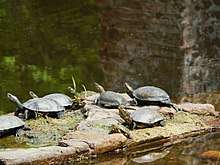
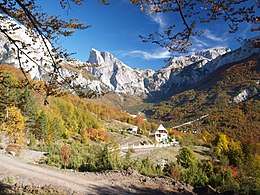
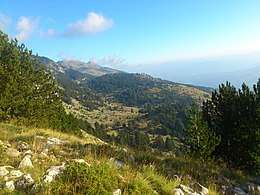
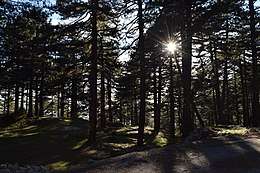
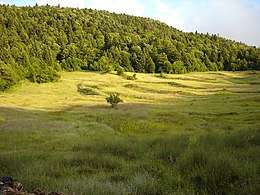
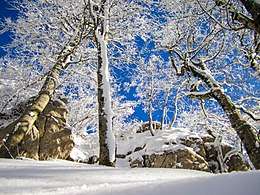
.jpg)
